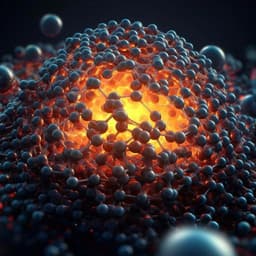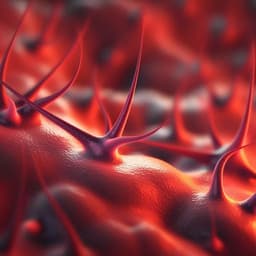
Medicine and Health
Brainmask: an ultrasoft and moist micro-electrocorticography electrode for accurate positioning and long-lasting recordings
B. Ji, F. Sun, et al.
Discover the groundbreaking 'Brainmask' micro-ECOG electrode, developed using the unique properties of bacterial cellulose, ensuring precise microelectrode positioning on nonplanar surfaces. This innovative biomaterial maintains exceptional signal quality for extended recordings, showcasing its potential for implantable neural interfaces. This research was conducted by Bowen Ji, Fanqi Sun, Jiecheng Guo, Yuhao Zhou, Xiaoli You, Ye Fan, Longchun Wang, Mengfei Xu, Wen Zeng, Jingquan Liu, Minghao Wang, Huijing Hu, and Honglong Chang.
~3 min • Beginner • English
Introduction
Implantable neural interfacing electrodes are essential research and clinical tools for recording and/or stimulating neural activity. Electrocorticography (ECOG) captures cortical local field potentials via flexible electrodes placed on the epi- or subdural surface. Recent advances have moved ECOG beyond short-term monitoring and intraoperative localization toward long-term implants for seizure prediction and prevention (e.g., FDA-approved RNS system) and for decoding motor, vision, or speech. However, chronic ECOG faces challenges: brain micromotion (blood flow, respiration, movement, intracranial pressure) causes relative displacement between electrodes and soft brain tissue, and mechanical mismatch induces foreign body responses, degrading signal quality. Thus, electrodes should be much softer to better match brain mechanics.
Conventional ECOG systems typically use silicone substrates with Pt–Ir macroelectrodes, which lack conformality due to thickness. Thin-film microelectrodes on polymers (polyimide, parylene-C, SU-8) offer higher channel counts and better conformal contact via low thickness but have limited mechanical strength and lack clinical approval (except NeuroOne Evo polyimide device allowed for up to 30 days). Reducing electrode stiffness is pursued via structural designs (mesh, strip, kirigami) or intrinsically soft materials. Structural approaches tradeoffs include interconnect constraints, implantation difficulty, and out-of-plane deformation compromising adhesion. Soft elastomers like PDMS improve compliance but pose patterning, bonding, and metal rupture issues; hybrid parylene-on-PDMS and serpentine transfer-printed elastomer strategies exist. Hydrogels are even softer but have limited processing accuracy, low spatial resolution, and unverified long-term biocompatibility/reliability.
A less-discussed issue is moisture management during implantation. Loss of cerebrospinal fluid at the electrode–brain interface can dry tissues, reduce signal quality, and increase adhesion and injury risk. Dripping ACSF may cause electrode flotation and separation; covering with absorbent materials retains moisture but obstructs visualization and may impede detection of displacement or hematoma. Acute experiments often require prolonged exposed craniotomies with ACSF to maintain moisture and hemostasis; hydrogels retain moisture but lack miniaturization precision.
To achieve conformal contact and lasting intraoperative moisturizing, the authors propose using bacterial cellulose (BC) film as the electrode substrate. BC is biocompatible, ultrasoft after hydration (Young’s modulus ~80–120 kPa), and exhibits strong water absorption/retention (fully hydrated mass ~100× dry), enabling both conformal adhesion to cortical topography and storage of ACSF whose weight helps press electrodes into contact. Potential challenges include BC’s poor insulation, limited micro/nanofabrication compatibility, and durability, requiring new packaging strategies. The work introduces Brainmask: parylene-C serpentine microelectrodes bonded to a moist BC substrate to combine precise site positioning with long-lasting signal quality in acute and week-long in vivo recordings.
Literature Review
The paper reviews existing ECOG technologies and strategies to enhance softness and conformality: (1) Commercial macroelectrodes (silicone with Pt–Ir) from vendors like Cortec, g.tec, PMT, Ad-Tech are thick and insufficiently conformal to cortical sulci/gyri. (2) Thin-film polymer microelectrodes (polyimide, parylene-C, SU-8) improve channel density and conformality via low thickness but suffer from limited mechanical robustness and lack of clinical approval, with the NeuroOne Evo (80 µm polyimide) allowed for 30-day human implantation. (3) Structural softening strategies include mesh (maintains relative site spacing but with interconnect constraints), strip (reduces constraints but complicates implantation), and kirigami (stretchable but induces out-of-plane deformation and poor tissue adhesion). (4) Intrinsically soft materials: PDMS substrates are softer but difficult to pattern with reliable metallization and bonding; hybrid parylene-on-PDMS and transfer-printed serpentine electrodes on elastomers have been explored. Hydrogels provide even lower moduli but are limited by processing accuracy, spatial resolution, and unverified long-term reliability. (5) Moisture management issues are highlighted: drying at the electrode–brain interface degrades signals; ACSF irrigation can float electrodes; absorbent coverings block visualization. These gaps motivate a substrate that is both ultrasoft and moisture-retaining. BC films, widely used in moisturizing facial masks, offer ultrafine mesh, high water absorption/retention, low hydrated modulus (80–120 kPa), and conformality, suggesting potential as implantable neural interface substrates despite concerns about insulation and durability.
Methodology
Device concept: Brainmask is a micro-ECOG comprising a moist bacterial cellulose (BC) film substrate with separated multichannel parylene-C serpentine microelectrodes bonded on its top surface. Electrode sites and bonding pads are exposed through the parylene-C layers; interconnects follow a fractal serpentine layout to enhance compliance. A representative device includes 9 independent channels with 100 µm site diameter and 700 µm pitch, connected via serpentine traces to a flexible flat cable (FFC).
Materials and key parameters: BC film acts as an ultrasoft, high-moisture-retention substrate. After hydration, BC exhibits Young’s modulus ~80–120 kPa and absorbs water to a mass ~100× its dry weight. An ultrathin, ultrasoft adhesive interlayer of Ecoflex Gel (elastic modulus ~33.4 kPa) bonds the parylene-C electrode film to the BC substrate while preserving flexibility and slight tackiness for positioning. Conductors are Au sandwiched between parylene-C layers. Device total thickness in demonstrations is ~1.35 mm (wet state, including BC and adhesive layers). Anisotropic conductive film (ACF; AC2056R, Hitachi) is used for hot pressing the pads to an FFC. Silicone sealant (K-5905L) seals the pad–FFC interface.
Serpentine electrode fabrication and handling: MEMS-fabricated parylene-C (and polyimide in supplementary examples) micro-ECOG arrays use fractal serpentine interconnects for conformal contact. To avoid tangling and ensure relative positional accuracy during release and assembly, retrieval via water-soluble polyvinyl alcohol (PVA) tape (ASWT-1) from the silicon wafer is employed (transfer printing). A small gel area is deliberately retained under the front edge (~0.5 mm length) of the rectangular pad region to provide mechanical strength for subsequent hot pressing and handling.
Assembly process (Fig. 2a): (1) Pick up the serpentine electrode from the silicon wafer using PVA tape, preserving interconnect spacing. (2) Dry the BC film at room temperature; coat its top surface with a thin Ecoflex Gel layer as an intermediate adhesive (avoid coating beneath the local pad area to preserve hardness for hot pressing). (3) Quickly laminate the serpentine electrode onto the gel-coated BC. (4) Slowly rinse the sample with deionized water at ~40 °C to dissolve the PVA tape while the BC film absorbs water and swells. (5) Heat the device in an air oven to evaporate water and return the BC to a dry state for pad bonding. (6) Hot press the pad area to an FFC using ACF (AC2056R), then seal the pad–cable interface with silicone sealant. (7) Rehydrate the BC to restore the device’s ultrasoft, moist state for implantation.
Positioning validation: To demonstrate the need for the BC substrate, electrodes without a substrate tangle and lose positional accuracy, whereas electrodes bonded to BC maintain accurate channel spacing. Attachment tests on a 0.6% agar gel cylinder (radius 5 mm, similar to rat brain curvature ~3 mm) show accurate positioning and conformal adhesion with the BC-backed device.
Softness and conformality comparisons: Samples of equal thickness (~1.4 mm) made from PDMS (E≈1.0 MPa), Ecoflex (E≈0.06 MPa), and wet BC are evaluated. On a developable cylinder (Gaussian curvature K=0), BC wraps best due to capillary adhesion and ultrasoftness; PDMS shows poor conformity; Ecoflex is intermediate. On a non-developable spherical surface (K≠0), wet BC maintains superior contact compared to PDMS and Ecoflex. Additional tests on periodic semicircular wave boards (radii 2.5 mm and 0.7 mm) reveal continuous gaps/bubbles for Ecoflex, but near-gapless adhesion for wet BC, including in valleys simulating sulci.
Finite element analysis (FEA): Using ABAQUS, two deformation states are simulated: 180° twisting and attachment to a periodic semicircular wave board (radius 2.5 mm). The Au interconnects exhibit maximum strain below the Au yield strain (≈0.3%) during twisting, remaining in the elastic regime; the highest stresses occur near electrode pads but are still below yield. During attachment, the device conforms to the wave board with positional fidelity of independent channels, aided by the thin gel adhesive layer. The von Mises stress in the BC film on the wave board reaches ~55 kPa (Supplementary), and global z-displacement maps confirm conformality.
In vivo/acute context: The Brainmask is designed to preserve moisture during acute implantation with an exposed cranial window and to provide stable in vivo recordings validated for up to one week (details referenced in abstract and figures).
Key Findings
- The Brainmask micro-ECOG leverages a moist, ultrasoft BC substrate bonded to serpentine parylene-C microelectrodes to achieve precise site positioning on complex, nonplanar cortical surfaces.
- Accurate positioning: Transfer printing with PVA tape and a thin Ecoflex Gel adhesive maintains relative interconnect positions, preventing tangling; BC-backed serpentine electrodes adhere conformally to a 0.6% agar gel cylinder (radius 5 mm), unlike bare serpentine films.
- Superior conformality/softness: Compared to equal-thickness PDMS (E≈1.0 MPa) and Ecoflex (E≈0.06 MPa), wet BC exhibits the best wrapping on cylinders (K=0) and maintains contact on spheres (K≠0). On periodic wave boards (r=2.5 mm and 0.7 mm), BC shows minimal gaps/bubbles, including at valleys simulating sulci, whereas Ecoflex shows continuous gaps.
- Mechanical safety: FEA (ABAQUS) shows maximum Au interconnect strain remains below ~0.3% (yield) under 180° twisting and during attachment to sharp curvature, indicating elastic operation and mechanical robustness. Von Mises stress in the BC film during adhesion tests peaks around 55 kPa.
- Moisture retention and recording stability: The hydrated BC stores large amounts of ACSF (hydrated mass ~100× dry), adding gentle weight that improves electrode–tissue contact and maintains moisture. The device improves long-lasting signal quality during acute implantation with an exposed cranial window for at least one hour and supports in vivo recordings validated for one week.
- Device metrics: Demonstrated 9-channel array, 100 µm electrode diameter, 700 µm pitch, serpentine interconnects; device wet thickness ~1.35 mm; pad bonding achieved via ACF to FFC with silicone sealing.
Discussion
The Brainmask addresses two key limitations of conventional and thin-film ECOG electrodes: mechanical mismatch with brain tissue and loss of moisture at the electrode–brain interface during surgery. By employing a hydrated BC substrate with a modulus (80–120 kPa) comparable to soft tissue and strong moisture retention, the device achieves superior conformal contact over complex cortical topographies (sulci/gyri) and maintains a moist interface without the drawbacks of continuous ACSF irrigation (electrode flotation) or absorbent covers (visual obstruction). The added mass of the hydrated BC enhances gentle pressure and contact quality, improving signal stability during acute procedures. The parylene-C encapsulation with serpentine Au interconnects ensures waterproofing and biocompatibility, while the Ecoflex Gel interlayer preserves channel positional accuracy during large deformations and facilitates assembly.
Comparative experiments against PDMS and Ecoflex confirm the unique conformal adhesion of wet BC on non-developable geometries, and FEA demonstrates that interconnect strains remain safely below Au yield during twisting and surface attachment, supporting mechanical reliability. Collectively, these findings suggest that an ultrasoft, moist BC substrate can mitigate micromotion effects and interface drying, enabling more stable ECOG recordings acutely and over at least a week in vivo, with potential applicability across animal models (rodents to primates).
Conclusion
This work introduces Brainmask, an ultrasoft and moist micro-ECOG platform combining a bacterial cellulose substrate with serpentine parylene-C microelectrodes. The device ensures accurate electrode positioning, superior conformal contact on complex cortical surfaces, and sustained moisture at the electrode–tissue interface. Mechanical analyses and bench-top geometrical tests validate elastic operation of interconnects and robust adhesion, while in vivo validation demonstrates improved acute signal stability and week-long recording capability. The approach highlights BC’s potential as a next-generation neural interface substrate. Future work should expand channel counts and spatial density, further optimize packaging/insulation strategies for BC-based substrates, evaluate long-term chronic biocompatibility and stability beyond one week, and translate the platform to larger animal models and, eventually, clinical settings.
Limitations
- Substrate material constraints: BC films inherently have poor electrical insulation, limited compatibility with standard micro/nanofabrication, and potential durability concerns; the study addresses these via parylene encapsulation and adhesive bonding but long-term robustness remains to be fully validated.
- Long-term data: While week-long in vivo recording is reported, chronic performance over months, foreign body response, and long-term packaging stability were not established in the provided text.
- Incomplete clinical readiness: Hydrated BC’s moisture retention and added mass are advantageous acutely, but effects on chronic tissue responses and CSF dynamics require further study.
- Processing precision: Although parylene-C microelectrodes provide high spatial precision, integrating BC with finer, high-density arrays may present challenges not fully explored here.
Related Publications
Explore these studies to deepen your understanding of the subject.







